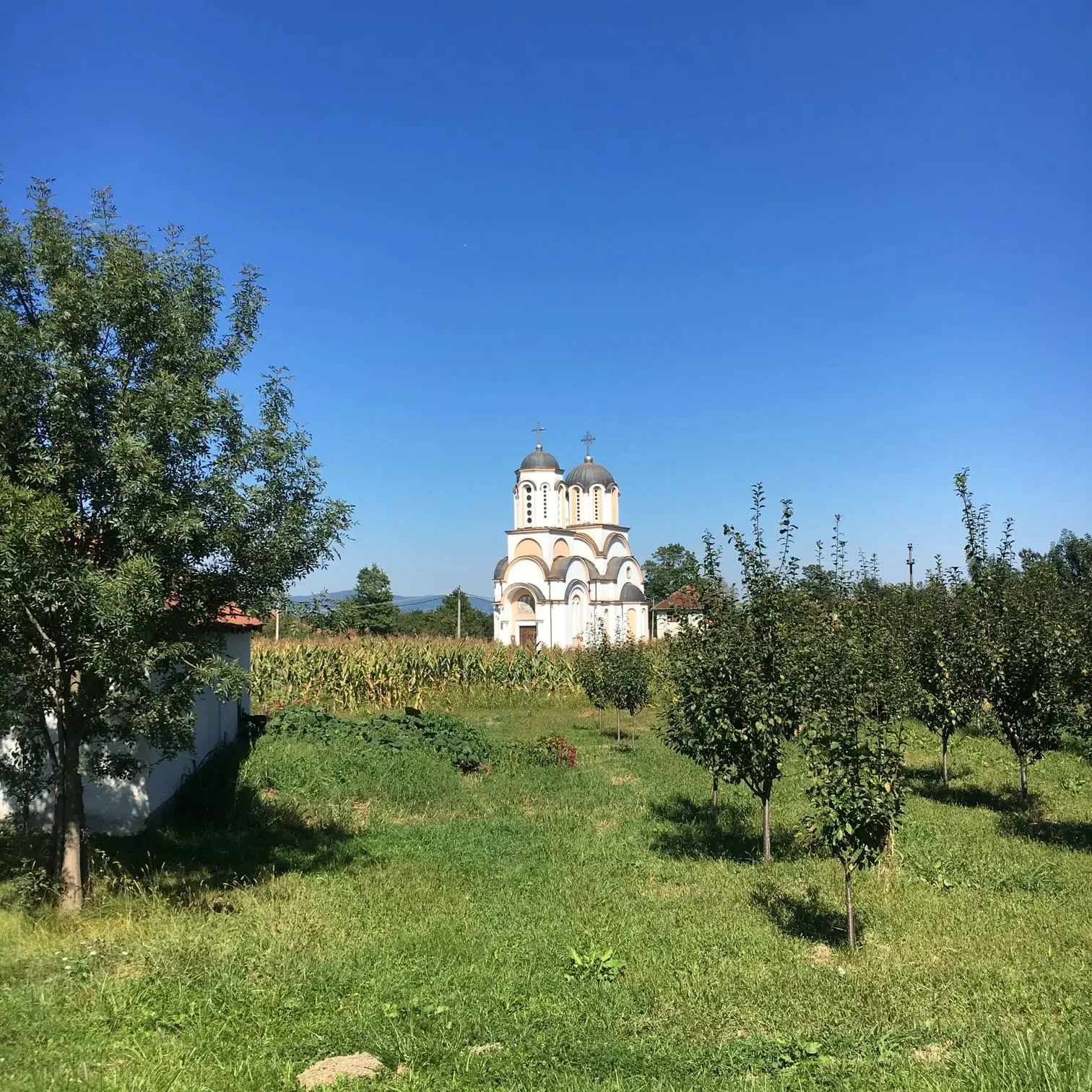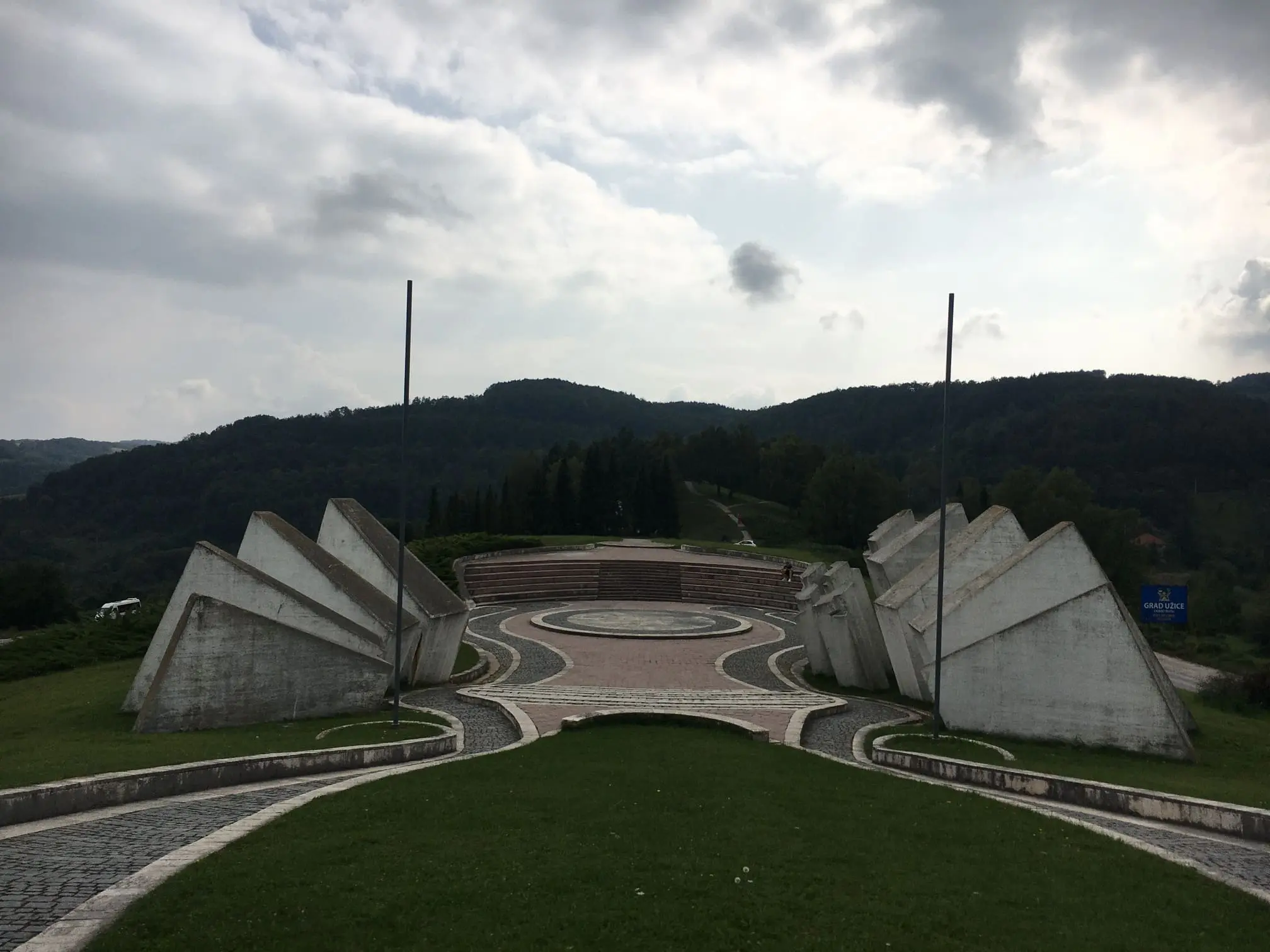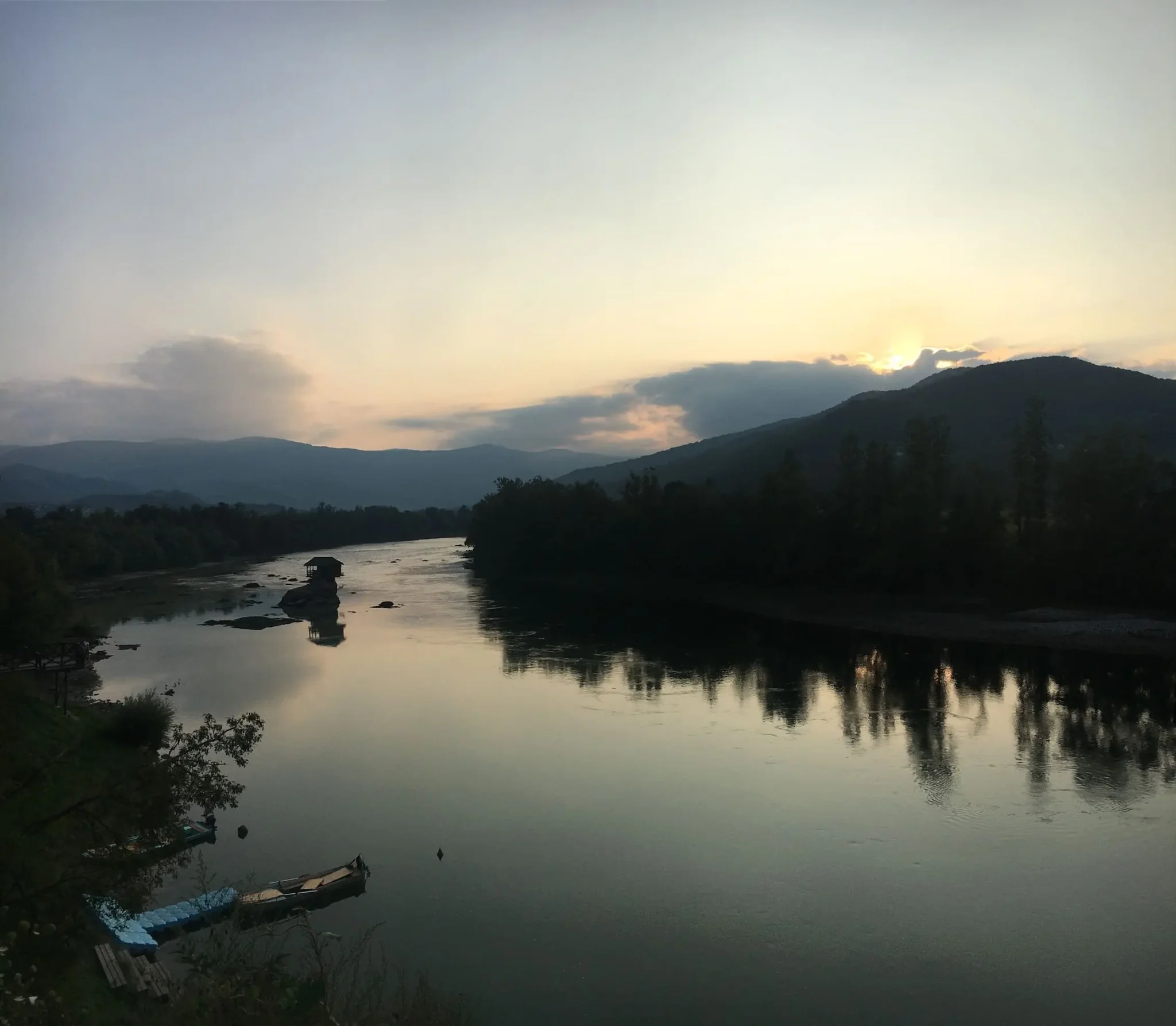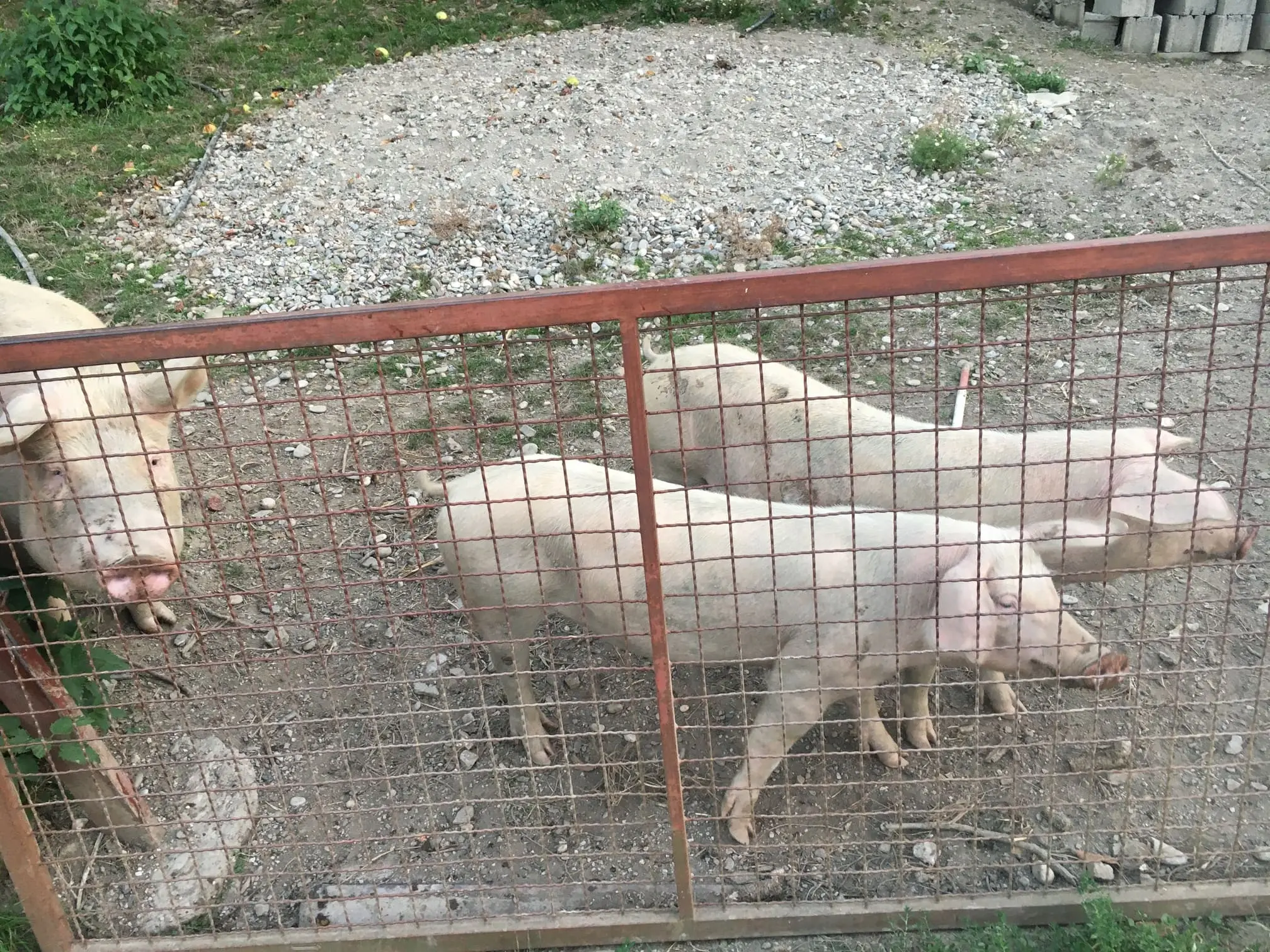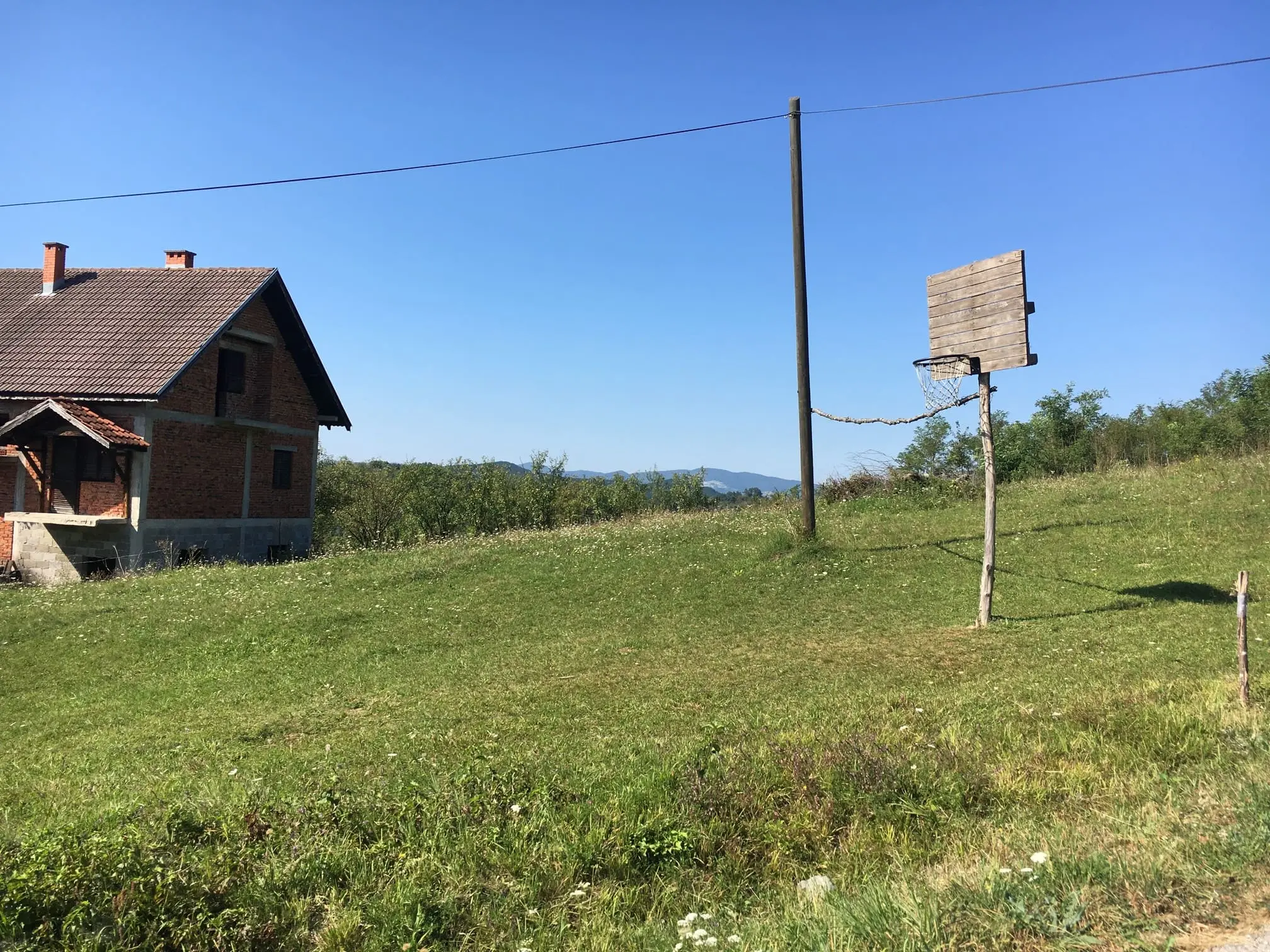I wake up at 7:30, the two dogs are still with me. I give them some leftover muesli I found at the bottom of my bags, hoping it suits them. I have another can of food that I’ll give them when I leave so they don’t follow me… which doesn’t work and they quickly start chasing me as I just want to reach the dam to start the lake tour. My heart breaks to leave them, but there’s nothing I can do; the panniers are too small to take them anywhere. I hope they’ll be okay and find their way in this remote part of the country 
The tour is 4 hours by boat and 1.5 hours of walking in an inaccessible area of the reserve. I also meet a Serbian-Polish couple, Milos and Olimpia. A former legionnaire (in France, he even spent time in Alsace, my holy Land), he has the look with his shaved head and well-defined Serbian features. Both are now diving guides and met in the Bahamas where they live. Quite a change of scenery between the Balkans and Poland to the Bahamas. Despite the Slavic connection, Olimpia doesn’t understand Serbian well, so Milos translates the guide for us, which is lucky for me 🙂
The reserve is home to griffon vultures (the same as in the Gorges du Verdon), bears, wolves, and many other species, including some types of snakes. The vulture can have a wingspan between 2.5 and 3 meters; they are very impressive. The Uvac is a river/lake created by a dam. It can be up to 95 meters deep, which is quite impressive. Swimming was previously allowed, but due to disrespectful environmental behaviors, they decided to close access to swimming.
The big problems in the park are venomous vipers and also the remains of animal bones that stay for a long time. A white eagle could help for the cleanup, but it’s not here.
We take a nice break at the top of the hike with a beautiful viewpoint. The Uvac “snake” is charming us. I have nothing to eat, but Milos shares a sandwich with typical regional fat from Zlatibor where we are. We manage to take a little group photo on the way back, and then we part ways.
My coming goal : find food for the evening and the next breakfast. I have nothing left after pampering the dogs from yesterday. I head towards the Studenica Monastery for tomorrow. On the way, I find a grocery store in a small village where the lady is shocked but mostly admiring to see a foreigner traveling by bike in Serbia, and she speaks decent English; it’s very cool :)!
After getting more food, I again search for a night camping spot; it’s definitely my specialty, but it’s very exhausting at night with traffic and low visibility to find something decent. I go on the side of the road behind some little mount so I can be slightly hidden.
Day 30 Ivanjica to Kraljevo (98 km)
Wake up at 7:00 : I want to leave early to reach Kraljevo after a big pass…
Well, one of my best mornings interferes with my plans as always. An old lady asks me if I want breakfast by communicating with hands and miming. First shy, I come back to her for water a few minutes later and she asks me again if I would like some food, I now say YES. I enjoy the hospitality of the couple I meet for a pleasant September morning.
Milica and Mališa pamper me for my greatest pleasure, fried eggs, garden tomatoes, meat sausage, bread, ham, Spack (bacon), and homemade fresh goat cheese, a delicious typical Balkan breakfast! I also receive a Turkish coffee; what a delight. Mališa is excellent in English (just from reading, listening to songs, singing…), so Milica can pass through him to ask me questions, which is very cute communication.
The couple lived in the capital but now want the tranquility of the countryside, which is really the case in the deep parts of Serbia. He is a fan of Partizan (one of the two main football and basketball clubs in Belgrade; Partizan is black and white, Red Star, … drum roll, red and white). But now he is more attracted to individual sports; they are fully behind Djokovic, of course.
They also teach me some Serbian words like: Prijatno: Bon appétit – Mlad: Young – Stari: Old.
Mališa tells me he has all the available social networks, Instagram, Facebook, WhatsApp, Viber, the main one being YouTube where he shares his guitar sessions: Dragomir Starcevic. They have a computer and a huge flat screen. He is 70 YEARS OLD WOW, I have never seen elderly people with so much technology and connectivity, especially from my village as an example. They really touched me.
Before restarting my two wheels, Mališa tells me his name means “little man” which may be true physically (for Serbian standards) but SO false in spirit. I will remember these two for a long time. I leave happy and sad at the same time at 11:30 instead of the planned 8:30, it’s going to be complicated again at the end of the day.
The pass is tough, but I manage to reach the Studenica Monastery around 14:30.
Historical interlude on Studenica and Serbian Orthodoxy
A little historical break obtained through a free guide: Built in the 12th century, it’s one of the oldest Orthodox monasteries and influenced all subsequent ones in Serbia. After the revolt against the Ottomans, which resulted in a defeat, the main church was burned. The restorer in the 19th century removed the soot but repainted it in a Baroque style and damaged the remains. It was only in the 20th century that this masterpiece of Serbian history was restored to its original state.
The frescoes depict battles against the Ottomans and the crucifixion of Christ (with gilding and lapis lazuli, it’s very beautiful). There are 33 windows for the 33 years of Christ, and the walls are 1 meter thick marble, which must weigh a lot of kilograms indeed. The first king of medieval Serbia (Nemanja) and his wife rest there.
I ask my 2-3 questions and find out that:
- Orthodox Christians kiss icons to venerate and thank the Saints but not worship; it’s different (only for God)
- The heart of the Orthodox Church should be in Hagia Sophia in Istanbul (Constantinople at the time), but the political and religious situation is complicated for that.
- The patriarch of the Orthodox comes before the Pope in their positions, but both have the same status.
- Marriage is authorized for churchmen, pope, the equivalent of priests for Catholics.
After this interlude, I head to Kraljevo and arrive at night to find a room a bit haphazardly. Here they call guesthouses like that Sobe; this one costs me around 15€, a bit of comfort does me good. A little bandit meal at the Meze Bar, for 400 dinars I get a great Gyros. Then I fall asleep from the fatigue of this day rich of culture and emotions.
Day 31 Kraljevo to Užice (95 km)
It’s Sunday, September 6, 2020, the last day of this first month full of adventures and twists. The hardest is probably behind me in terms of climbs, even if I will extend the trip to see Leo (a former colleague) in Belgrade. I’m already at 1610 km and 20,400 m of elevation gain BENG BENG.
Late departure at 12:15 for Čačak then Užice (pronounced Tchatchak and Ujitse in English). In Čačak, I stop at a pizzeria and meet Luka who works on machines and is a former taxi driver, and Nikola, a high school student who aims to study in Slovenia. Luka doesn’t quite understand my travels, being a big homebody. They warn me that I should be careful in Serbia, but honestly, in this first week, I feel little danger in all my interactions. The rest of the day’s route will be folkloric with a steep pass then a “nice” national road at night, not to be repeated; it’s scary, especially when people honk at you.
Upon arriving at the hostel, I meet a Japanese man (Daisuke), more on papers than his (very free) spirit. A traveler (years in Europe which he loves, like his 4 months in Bulgaria, for example), very disconnected and super comfortable chatting. Then I meet a Serbian man, Janov, who switched from management to coding in PHP as a self-taught.
Finally, I discover how to write my name in Serbian Cyrillic: Флорент I think it looks cool.
Day 32 Užice / Mokra Gora / Drvengrad Pause
Finally, a break with my trusty steed, my posterior was starting to ache for some time.
I take the bus to Mokra Gora (Wet Mountain) for 400 Dinars, about an hour’s ride as recommended by the hostel, and the same for the return trip (note for later).
I meet Marko and Milica, a Serbian couple on the Sargan Eight (a train that loops through the mountains). They describe Serbia, the cuisine, and Marko shares his views on Slovakia and Bratislava where he works. He even encourages me to consider applying for jobs there with his contacts. They help me decipher the last Cyrillic letters I couldn’t grasp. I join them in their car to visit Drvengrad (the village built by Emir Kusturica for his film “Life is a Miracle”).
We enjoy the beautiful scenery and on the way back to drop me at the bus stop… they inform me there are no more buses back to Užice… I’m 50 km away, not ideal, but Marko, who lives on the opposite side, helps me negotiate with an old gentleman to take me there for 2000 dinars (5 times the bus fare eh). Take it or leave it, I prefer to get back, so I decide to go for it.
Once at the hostel, I let them know their return instructions were incorrect. I meet Joel, a friendly and talkative American. He lives in California but is from New York and is visiting one of the few countries he can travel to during Covid times. He’s a fan of my journey and also enjoys cycling, he wants to join me a bit for my departure tomorrow, we’ll see how it goes. We go to two different bars, discuss similarities and differences between the United States and France. Then Joel starts chatting up some girls, telling me I have a chance, I’m embarrassed and not interested. However, we stay until one in the morning. It’s going to be another fun day starting tomorrow 🙂
Day 33 Užice to Bajina Bašta (60 km)
Departure at 13:00 only : I’m late due to breakfast in town and waiting for Joel to get ready. We take a somewhat steep hill to a monument that turns out to be closed. Joel, who was supposed to accompany me for an hour, gives up after 25 minutes due to fatigue, see you soon. It was nice, but probably for the best for both of us.
I aim for the Drina River now, forming the border with Bosnia. I pass by the Užicka Republika monument, a micro-republic formed to resist the Nazi occupiers, celebrated by one of the many brutalist-style monuments under Tito’s reign over post-war Yugoslavia.
Monument de l’Užicka Republika
I then arrive in Bajina Bašta; the Drina is beautiful and calming border between Serbia and Bonsia, you could almost not believe there was a war over 20 years ago. My quick meals in Serbia are delicious because they have very good bakeries for savory pastries, lots of dough of course but with great combinations (spinach, cheese, minced meat, etc.).
I pass through real Serbian villages; their charm is superb, rustic but you can see people care about them. I even see people carrying a couch in their hands while on the roof of a car, it’s surprising (and slightly dangerous) 😀
For the evening, I navigate the meanders of the Drina and look for a place to pitch my tent. I still hesitate to ask locals to pitch my tent in their garden, it scares me, maybe next time.
Farmyard Team
Day 34 Bajina Bašta to somewhere in the center of Serbia (70 km)
Departure at 10:45, towards Topola, which I’ll reach in 2 days as it’s too far for a single day effort.
I tackle very steep areas in the southwest of the country, and my exhausted body needs rest: the brief single-day breaks are too short. I look forward to Belgrade and several days without pedaling, which will do me good. This transitional day doesn’t have much to tell.
Everyone is very kind despite the language barrier and very helpful; the Serbian hospitality for travelers isn’t a myth, they are adorable, and I keep wondering why I should worry about camping here. The only concern is a group of Roma who approach me for cigarettes or money, but in the end, rejecting them causes me no trouble.
To pitch the tent (for once, on time and perfectly set up), I glimpse a superb sunset that I enjoy until nightfall, dreaming of the days ahead and sunbathing for a few minutes.
Day 35 In the middle of Serbia to Topola (70 km)
Departure at 9:00 : I wanted to head more towards Belgrade, but today’s events allow me to enjoy Topola longer, which is more attractive than one might think. These will be my last real climbs in Serbia and beyond (Belgrade, Vojvodina, and Hungary should be relatively flat if all goes well). In Topola, I go to the Vožd restaurant, where I order a rump steak and then a fig tart, YUM. The waiter is quite nice too. He teaches me how to say goodbye: Dovidenja. He recommends me to visit the mausoleum of the last Serbian kings, which I go for right after.
Historical interlude #2 on Topola and the last Serbian royal dynasty
The guides are very kind, it’s much appreciated.
- The royal mausoleum of Oplenac, built between 1910 and 1925, houses the Karađorđević dynasty (28 members of the last line of Serbian kings). The interior features over 3500 m² of mosaics, which amounts to more than 40 million small squares, it’s incredible. The chandelier in the middle of the building is made of copper from weapons used in World War I, weighing about 3 tons. On the left facade, the mosaics depict Christ and the patron saint of the building, St. George.
On the right, it’s unusual for an Orthodox religious monument, all the sovereigns from the foundation of medieval Serbia to the last before the Ottoman conquest (around the 15th century) are represented with the most important edifice created under their reign. (Studenica and its founder in 1st place or Zica, the church of the coronations of kings, in 2nd). At the entrance, you can see the founder of the Mausoleum, Peter I. The sovereigns used to create one or more monuments to showcase the art and technique of their time and to create social cohesion, which was one of the few ways to achieve it at that time. - Mausoleum Museum: After the death of Peter I, his son Alexander ruled before his assassination in Marseille in 1934 by Croatian / Macedonian separatists. His supposed son to reign at majority did not succeed because after the end of World War II, Tito (Josip Broz) came to power and chased the royal family for a totalitarian Yugoslav republic (he ruled there for more than 30 years).
The exiled royal family lost their fortune and even had to sell their jewels, the mausoleum retains only a diadem of Maria, for example.
I then witness many artworks by Serbian or at least Orthodox artists. Like a perspective icon in olive wood of small size but with micro details. History says it’s a monk from Athos (a kind of Orthodox Vatican where only men can access) who spent his life on it. Then I see a marble icon of the Last Supper / La Cène that Goering would have looted during the war a few years after seeing it at the funeral of King Alexander; Goering was a big collector from what I am told.
Apart from religion, you can also see the declaration of war by Austria-Hungary on Serbia written in French, as it was the language of diplomacy at that time. Pretty cool to be able to read it entirely in your mother tongue. Finally, there is a saber offered by the Bosnians after World War I with a pommel rich in details (rubies, lion shape representing the king, scabbard with battles). - Old town ruins and origin of Karađorđević: Karadorde (grandfather of Peter I) instigated the first Serbian revolution against the Ottomans in the 19th century, resulting in a resurgence of independence among the population in subsequent years. A piece of one of the cannons from the old town is missing; it was used to forge the crown of Peter I in homage to his ancestor.
After this rich visit, I go shopping and quickly find a tent spot hidden from the city.
Tomorrow is the final stretch before my third real objective of the trip, the White City: Belgrade. I am looking forward to meet my friend Léo again. For that, see you in next week’s article!












